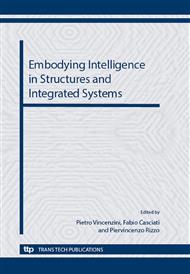[1]
Schilders W. H. A. , van der Vorst H. A. , Rommes J. Model Order Reduction: Theory, Research Aspects and Applications, Springer, 2008.
DOI: 10.1007/978-3-540-78841-6
Google Scholar
[2]
Carlberg K., Bou Mosleh C.,Farhat C., Efficient non-linear model reduction via a least-squares Petrov-Galerkin projection and compressive tensor approximations, International Journal for numerical methods in engineering, 86:155-181, 2011.
DOI: 10.1002/nme.3050
Google Scholar
[3]
Casciati F., Casciati S. , Faravelli L., Franchinotti M., Model Order Reduction vs. Structural Control, Proceedings ACMA2012, Fez Morocco, (2012)
Google Scholar
[4]
Casciati F. , Faravelli L., Franchinotti M., Model Order Reduction vs. Structural Control, Proceedings EACS2012, Genova, Italy, 2012.
Google Scholar
[5]
Casciati F., Casciati S. , Faravelli L., Franchinotti M., Model Order Reduction vs. Structural Monitoring, Proceedings EWSHM2012, Dresden, Germany, 2012.
Google Scholar
[6]
Bouc R., Forced vibration of mechanical systems with hysteresis. In Proceedings of the Fourth Conference on Nonlinear Oscillation. Prague, Czechoslovakia, p.315, (1967)
Google Scholar
[7]
Wen Y. K. Method for random vibration of hysteretic systems. Journal of Engineering Mechanics. ASCE. Vol. 102, No. 2. p.249—263, 1976.
Google Scholar
[8]
Casciati F., Stochastic Dynamics of Hysteretic Media, Structural Safety, 6, 2-4, 259-269, 1989.
DOI: 10.1016/0167-4730(89)90026-x
Google Scholar
[9]
Casciati F., Faravelli L., Fragility Analysis of Complex Structural Systems, Reasearch Studies Press, Taunton, UK, (1991)
Google Scholar
[10]
Casciati F. and Faravelli L., Stochastic Equivalent Linearization for 3-D Frames, Journal of Engineering Mechanics – ASCE, 114, 10, 1760-1771, 1988.
DOI: 10.1061/(asce)0733-9399(1988)114:10(1760)
Google Scholar
[11]
Ohtori Y., Christenson R. E., Spencer, B. F., Benchmark Control Problems for Seismically Excited Nonlinear Buildings. J. Eng. Mech. 130, 366, 2004.
DOI: 10.1061/(asce)0733-9399(2004)130:4(366)
Google Scholar
[12]
Sack, R.L.,. Matrix Structural Analysis, PWS-Kent Pub. Co., Boston,1989.
Google Scholar
[13]
MATLAB The Math Works, Inc., Natick, Massachusetts,1997.
Google Scholar
[14]
Antoulas A.C., Approximation of Large-Scale Dynamic Systems, SIAM, 2005.
Google Scholar


